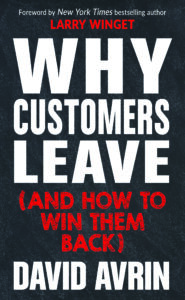(And How to Win Them Back)
Customers have endless choices today. With a single click, you can lose them.
David Avrin’s new book, Why Customers Leave: (And How to Win Them Back) , is a window into the customer experience as a true differentiator. David shares twenty-three ways that businesses unknowingly drive customers to leave, and then how to change that in a hurry. David Avrin is an author and speaker on the customer experience, and I spoke to him about his recent book.
Pitfalls to Avoid
Since I wrote The Book of Mistakes, it’s safe to say I am fascinated by the big mistakes people and businesses make. You share numerous common pitfalls that drive customers to leave. How did you develop the list?
I have been speaking, teaching and consulting on marketing and branding for 30 years, and I began to notice a disturbing trend. I could create significant exposure for companies and brands, drive customers and initial trial, but I had no control over how those people were treated once they became customers. They were not my customers. They belonged to my clients.
So, I began doing research — anecdotal and otherwise — trying to recognize why prospective customers leave or don’t buy. What was frustrating them and driving them into the open arms of competitors? And to be honest, it wasn’t hard to get people talking, and certain themes took shape very quickly: speed of service, restriction of access, rigidity of policies, complexity of technology, easy of process.
The part that was so surprising was the level of denial that most in business were in, believing that these customer complaints don’t apply to them.
So, in writing the book, I decided early to break each short chapter into a specific offending behavior, policy or tactic employed by business and offer specific examples that everyone could relate to. I also wanted to let business leaders know that I understood that there was no nefarious intent behind the often ill-conceived policies, so I clarified the business rational behind the behavior. But I also made it clear where the disconnect was between their intentions and our perceptions. Finally, I offer a better alternative. In short, every chapter ends with a section that includes: “Why you do it,” “Why we hate it,” and “A Better Approach.”
Why It’s Getting Worse
If we’ve been talking about the importance of customers service for decades, why does it seem to be getting worse?
I think business leaders understand “customer service.” Service with a smile….treat them like you want to be treated, etc. But leaders are too often confusing the service they deliver with the experience we, as customers receive. Friendly staff has little to do with telephone hold times, confusing mobile apps, websites with no contact information and policies that offer very little flexibility or freedom for their team members to accommodate requests.
I think the reasons that customer service seems to be getting worse are two-fold:
- Our exceptions have risen, so our perception of “good service” or a “good experience” is skewed. Technology has dramatically changed our expectation of what fast, convenient and “broad selection” means. Twenty years ago, it meant being really good; it meant what you offered, and it meant meeting our expectations. Today it means endless choices, buying with one click and getting it in 30 minutes or less. Those who can’t or won’t accommodate our growing demands are perceived as “poor” market players.
- Second, service in its purest form has gotten worse because companies have morphed from catering to customers to being driven by metrics; from finding ways to accommodate, to adhering to predictive paths. Blame it on stiff competition. With so much out of their control, leaders are seeking ways to control what they can. From this mindset has come the “franchise approach.” It is believed that if we can just control the policies, procedures and customer path, we can have greater predictability in terms of product preference, buying behavior, revenue and, ultimately, profit. The problem with the model is it leaves little room for flexibility or accommodation of needs that deviate from the predictive model. Translation: wW no longer feel special, valued or catered-to.
Why Customers Leave
The book is called: Why Customers Leave. So, why do customers leave?
 At the most basic level, they leave because they can. There has never been a time with more options for how to buy, and more great choices of whom to buy from. And with so many options being only a cell phone or a mouse click away, it doesn’t take much for a customer to turn to other options.
At the most basic level, they leave because they can. There has never been a time with more options for how to buy, and more great choices of whom to buy from. And with so many options being only a cell phone or a mouse click away, it doesn’t take much for a customer to turn to other options.
This convenience revolution has bred a population of impatient, intolerant and demanding customers. It’s not just “them,” it’s all of us. If a company says “no,” there are likely others who will say ‘yes.’ If you make us wait on hold, we will quickly lose our patience and become frustrated…at you! If you bombard us with requests to take a survey day after day, you will turn our perceptions of a good encounter into a bad one. And if we buy from you one time and you email us every day thereafter urging us to buy more, we will unsubscribe.
Any on the list of frustrations that surprised people?
Absolutely. The one bottleneck that most in business never think about is the website “contact form.” The disconnect between the intent and the effectiveness couldn’t be wider. The reality is that people almost always want to reach a real person when they have a question or an issue to resolve. More and more, companies are making the conscious choice to not provide individual contact information, while too many others won’t even offer up an email address. It is universally frustrating — and not the feeling you want to engender in your important customers and clients.
The option that too many organizations provide instead is the dreaded website contact form. The rationale is easy to understand. They think: “We will just have people fill out the form. Then we can capture their information for later marketing. We can even ask them some pre-qualifying questions to tailor our offering. It’ll be great!”
Here’s the problem: People hate filling out the form. They won’t in many cases. They wanted to talk to a real person, or email a real person, but you wouldn’t let them. They have no idea who will get the contact form information, or when someone might actually respond. That uncertainty is a nail in the coffin in terms of compliance. Most will simply opt-out and walk away in frustration. The worst part is that you have no idea who they were, or how many left without leaving their information. The website contact form is the answering machine of the internet—a terrible strategy when it’s the only contact option.
You’ve been crisscrossing the globe speaking to audiences and consulting with businesses. What’s your view of the global business and whether these problems are country-specific or global?
There will always be country-specific issues in terms of cultural attitudes surrounding trust/corruption, class expectations and respect, but the broader realities of vast selection, high quality and intense competition are universal. Everyone everywhere is more and more finding themselves competing against everyone from everywhere. The world is indeed flat, options are a click away and prices are fairly comparable.
So, the bigger issue is where do we find competitive advantage? For most of history, we competed on the quality or features of the product or service itself. Today, when virtually everyone is good, companies are finding opportunities to distinguish themselves by envisioning, crafting and providing a superior customer experience. And to be clear, it’s not about creating “wow” moments. It’s about being extraordinarily easy to do business with. It’s about eliminating points of frustration, being flexible, fast and memorable across the entire customer journey. Those concepts play well world-wide.
For more information, see Why Customers Leave: (And How to Win Them Back) .


